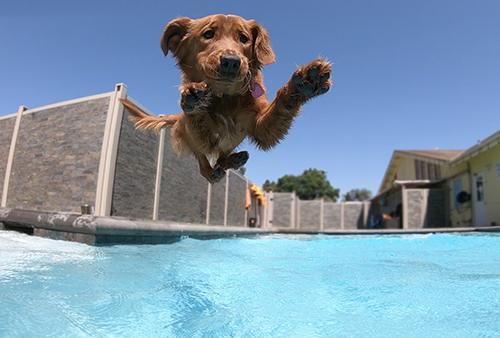
Dogs can get a lot out of a day at the pool or beach. Help keep them safe with these expert tips.
Some dogs can’t wait to take a dip in the pool on hot days. Others are a little more wary and may require some persuasion.
Regardless of your type of dog, spending a day at the pool or dog beach can have many benefits.
“Swimming itself is a great type of exercise for dogs because it has low impact on their bones but provides a good amount of resistance due to the water, which enables them to work their muscles more in a shorter amount of time than just running or walking alone, improving their cardiovascular health,” said Breana Dorame, manager at the Swim Club for dogs, which opened in September 2018 at one of The Bone Adventure’s (www.theboneadventure.com) Costa Mesa locations. “Besides swimming being a great exercise for dogs, it also provides great mental stimulation for them. We specifically use toys to provide a drive for the dogs to be motivated to get into the water, almost every dog out there has their own favorite.”
Dorame said that even some of the more reluctant dogs have come around.
“Tanner, a pool regular, is an Australian shepherd that would not go into the deep end of the pool for quite some time,” she said. “We used his obsession with his favorite toy to slowly get him to be more confident at jumping in. We never thought he would jump in on his own at first, and now he will jump off the two-foot-tall dock.”
With all the fun and exercise canines can get from the water, it’s not without some risks. Of course it doesn’t mean dogs shouldn’t go out for a swim.
“There will always be risks to be mindful about when taking your dog to swim at a pool, beach or body of water, just like there are for people too,” said Dorame.
To help pet parents out, Dorame offered some advice on canine safety when out in the water:
Risk: Sunburn
Tip: “Apply sunscreen,” Dorame said. “A common area for dogs to get sunburnt is on the nose and head, but anywhere the skin is exposed to the sun is susceptible. This is common in lighter dogs like bull dogs, bull terriers, Dalmatians, etc. We recommend applying baby sunscreen—lotion or spray—to your hands first, then applying to the dog, making sure to rub it in well and avoid the eyes and mouth. Again, be sure to rinse the dog after.”
Risk: Drowning
Tip: “Use of a lifejacket with a handle is ideal for any beginner swimming dog,” Dorame said. “The handle is useful to easily grab a dog from any body of water. … Be familiar with canine CPR.”
Risk: Exhaustion
Tip: “Give breaks to keep them from overdoing it—30 minutes of swimming is usually a prime amount of time for the average dog,” said Dorame. “Provide shaded areas.”
Risk: Ingestion of pool water, salt water, sand, foreign objects, dead fish and dirty water
Tip: “Always provide clean drinking water,” said Dorame. “Never leave the dog alone while swimming.”
Risk: Life-threatening bloat
Tip: “Make sure the dog hasn’t eaten at least an hour before or after their swim session,” Dorame said.
Risk: Urinary tract infections, ear infections and skin issues
Tip: “Rinse your dog off after swimming in any type of water,” Dorame said.
By Jessica Peralta









Leave a Reply